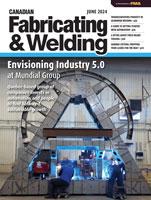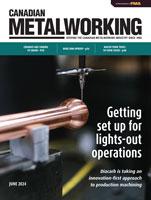- FMA
- The Fabricator
- FABTECH
- Canadian Metalworking
Boeing is bringing in the robots
Boeing has been developing this new technology, known as the Fuselage Automated Upright Build (FAUB), since 2012, in an effort to improve workplace safety and increase product quality.
- July 18, 2014
- News Release
- Metalworking

Boeing is in the final phases of testing and production readiness of a new method for building 777 fuselages. Known as the Fuselage Automated Upright Build, this advanced manufacturing technology is expected to improve workplace safety and increases product quality. (photo: SAE International)
The Farnborough Air Show is coming to an end. Major aerospace companies have been vying for the best contracts and sales records. However, the show also yeilded some great new innovations when it comes to airplane manufacturing. Boeing announced that it is in the final phases of testing and production readiness of a new method for building 777 fuselages.
Boeing has been developing this new technology, known as the Fuselage Automated Upright Build (FAUB), since 2012, in an effort to improve workplace safety and increase product quality.
"This is the first time such technology will be used by Boeing to manufacture wide-body commercial airplanes," said Elizabeth Lund, Vice President and General Manager, 777 program and Everett site, Boeing Commercial Airplanes. "We're excited to continue improving the production process here and we're positioning ourselves to begin building 777X airplanes in the future."
FAUB allows for fuselage sections to be built using automated, guided robots that will fasten the panels of the fuselage together, drilling and filling the more than approximately 60,000 fasteners that are today installed by hand.
What does this mean for jobs? It is inevitable that some jobs will be replaced by the introduction of robotics. However, this does not mean that Boeing will be slashing jobs. This new process enables high build rates, creating additional jobs. Boeing also says that workers will need be retrained to operate and manage the FAUB. The company is working towards developing advanced technology to create new jobs and ramp up productivity and safety.
According to Boeing, more than half of all injuries on the 777 program have occurred during the phase of production that is now being automated. In addition, the automated system is expected to reduce build times and improve first-time quality of the build process.
The 777 program has already begun testing FAUB at a facility in Anacortes, WA and will be installed in Everett in a new portin of the main factory that is under construction now. Production readiness preparations are underway and the technology is expected to be implemented in the next few years.
Boeing is currently developing its technology investment strategy and the 777 program is just one way that it is exploring production enhancements. This new system was designed by KUKA systems for Boeing. Is the latest in a series of strategic advanced manufacturing moves, which have already included new systems for painting wings and other drilling operations.
SOURCE SAE International
subscribe now


Keep up to date with the latest news, events, and technology for all things metal from our pair of monthly magazines written specifically for Canadian manufacturers!
Start Your Free Subscription- Industry Events
MMTS 2024
- June 18 - 20, 2024
- Montreal, QC Canada
RAPID + TCT
- June 25 - 27, 2024
- Los Angeles, CA
IMTS 2024
- September 9 - 14, 2024
- Chicago, IL
WiM Summit 2024
- October 6 - 9, 2024
- Boston, MA
FABTECH 2024 Orlando
- October 15 - 17, 2024
- Orlando, FL



















